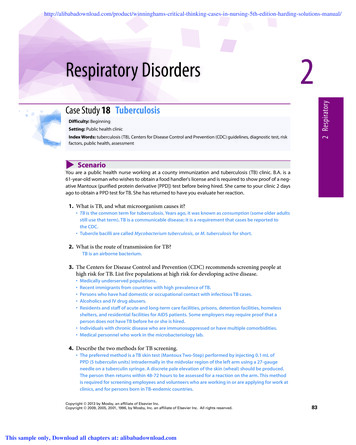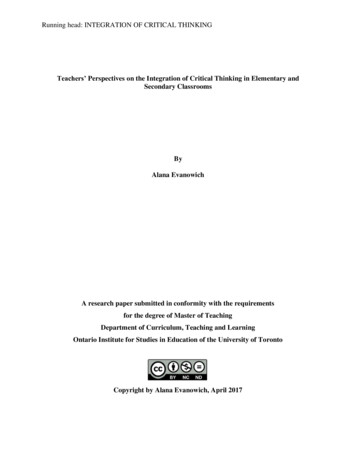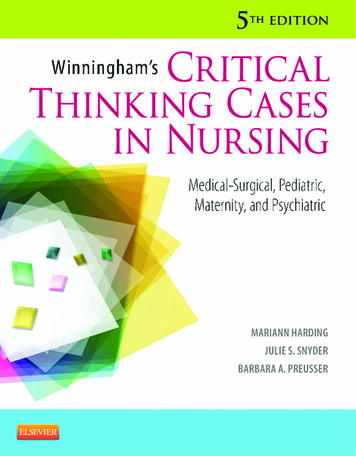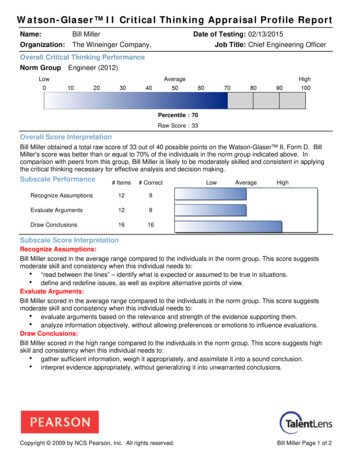
Transcription
Winninghams Critical Thinking Cases in Nursing 5th Edition Harding Solutions ManualFull Download: g-solutions-manual/22 RespiratoryRespiratory DisordersCase Study 18 TuberculosisDifficulty: BeginningSetting: Public health clinicIndex Words: tuberculosis (TB), Centers for Disease Control and Prevention (CDC) guidelines, diagnostic test, riskfactors, public health, assessmentX ScenarioYou are a public health nurse working at a county immunization and tuberculosis (TB) clinic. B.A. is a61-year-old woman who wishes to obtain a food handler's license and is required to show proof of a negative Mantoux (purified protein derivative [PPD]) test before being hired. She came to your clinic 2 daysago to obtain a PPD test for TB. She has returned to have you evaluate her reaction.1. What is TB, and what microorganism causes it? TB is the common term for tuberculosis. Years ago, it was known as consumption (some older adultsstill use that term). TB is a communicable disease; it is a requirement that cases be reported tothe CDC. Tubercle bacilli are called Mycobacterium tuberculosis, or M. tuberculosis for short.2. What is the route of transmission for TB?TB is an airborne bacterium.3. The Centers for Disease Control and Prevention (CDC) recommends screening people athigh risk for TB. List five populations at high risk for developing active disease. Medically underserved populations.Recent immigrants from countries with high prevalence of TB.Persons who have had domestic or occupational contact with infectious TB cases.Alcoholics and IV drug abusers.Residents and staff of acute and long-term care facilities, prisons, detention facilities, homelessshelters, and residential facilities for AIDS patients. Some employers may require proof that aperson does not have TB before he or she is hired. Individuals with chronic disease who are immunosuppressed or have multiple comorbidities. Medical personnel who work in the microbacteriology lab.4. Describe the two methods for TB screening. The preferred method is a TB skin test (Mantoux Two-Step) performed by injecting 0.1 mL ofPPD (5 tuberculin units) intradermally in the midvolar region of the left arm using a 27-gaugeneedle on a tuberculin syringe. A discrete pale elevation of the skin (wheal) should be produced.The person then returns within 48-72 hours to be assessed for a reaction on the arm. This methodis required for screening employees and volunteers who are working in or are applying for work atclinics, and for persons born in TB-endemic countries.Copyright 2013 by Mosby, an affiliate of Elsevier Inc.Copyright 2009, 2005, 2001, 1996, by Mosby, Inc. an affiliate of Elsevier Inc. All rights reserved.This sample only, Download all chapters at: alibabadownload.com83
PART 1MEDICAL SURGICAL CASES TB blood tests (also called interferon-gamma release assays or IGRAs) measure how the immunesystem reacts to the bacteria that cause TB. A TB blood test requires only one visit to draw blood forthe test. The QuantiFERON-TB Gold test (QFT-G), QuantiFERON-TB Gold In-Tube test (GFT-GIT), andT-SPOT.TB test are three Food and Drug Administration–approved TB blood tests. Test results aregenerally available in 24 to 48 hours.2 Respiratory5. How do you determine whether a Mantoux test is positive or negative? You measure the area of induration (not erythema), which is defined as a hardened area under theskin. The area is measured transverse to the long axis of the forearm. The CDC has the following guidelines for positive Mantoux reaction: A PPD induration greater than 5 mm is considered positive for persons with, or at risk for, HIVinfection; those who have had close, recent contact with someone who has infectious TB; orpersons who have a CXR that shows old, healed TB, patients with organ transplants, and peoplewho are immunosuppressed for other reasons. A PPD induration greater than 10 mm is considered positive for foreign-born persons fromhigh-prevalence countries; IV drug users; medically underserved, low-income populations;residents of long-term care facilities; people with chronic illnesses; mycobacteriology labpersonnel; and all children and adolescents. A PPD induration greater than 15 mm is considered positive for all other persons.CASE STUDY PROGRESSB.A. consumes 3 to 4 ounces of alcohol (ETOH) per day and has smoked 1.5 packs of cigarettes per day for40 years. She is a natural-born American, has no risk factors according to the CDC guidelines, lives withher daughter, and becomes angry at the suggestion that she might have TB. She admits that her motherhad TB when she was a child but says she herself has never tested positive. She says, “I feel just fine and Idon't think all this is necessary.”6. What additional information would you want to obtain from B.A. before interpreting herskin test result as positive or negative? Obtain a social history: ETOH ingestion, prescription or illegal drug use, smoking history; notedomestic and occupational conditions. Take a medical history: Exposure to TB, S/S of active TB infection, medications, PMH. Find outwhether she has had regular access to health care. Ask about current symptoms.7. Determine whether B.A.'s skin test is positive or negative.mm10 20 30 40 50B.A.'s test is positive because the area of induration is greater than 15 mm.84Copyright 2013 by Mosby, an affiliate of Elsevier Inc.Copyright 2009, 2005, 2001, 1996, by Mosby, Inc. an affiliate of Elsevier Inc. All rights reserved.
CHAPTER 2RESPIRATORY DISORDERSCASE STUDY 188. B.A. asks you what a positive PPD result means. How will you respond?B.A. has been exposed to infectious TB. Because previous testing has been negative and this test waspositive, B.A. may have been exposed to active TB since her last negative Mantoux test.9. What steps will need to be done to determine whether B.A. has an active TB infection?2 RespiratoryFirst, B.A. will need a CXR. For persons with reactions greater than or equal to 10 mm and persons withsymptoms suggesting TB (e.g., cough, anorexia, weight loss, fever)—regardless of the size of theskin-test reaction—this should be done within 72 hours. If the CXR is abnormal, and/or symptomscompatible with TB are present, the patient should also have sputum smear and culture examinations.At least three sputum specimens should be submitted. In the absence of spontaneous productionof sputum, suction of laryngeal or pharyngeal mucus is satisfactory if sterile water is used in clearingthe catheter.CASE STUDY PROGRESSThe physician orders a chest x-ray (CXR) and informs B.A. that her CXR is clear (shows no signs of TB). Hetells her that she has a latent TB infection and that he will report her condition to the local public healthdepartment. The health department will monitor her over time and initiate treatment if she gets TB.10. What is a latent TB infection (LTBI)?Persons with LTBI are infected with M. tuberculosis but do not have active TB disease; they do notfeel sick or have any symptoms. The only sign of a TB infection is a positive reaction to the tuberculinskin test or to the TB blood tests. Persons with LTBI are not infectious and cannot spread TB infectionto others. Overall, about 5% to 10% of patients with latent disease will develop active TB disease atsome time in their lives. About half of those people who develop active TB will do so within the first 2years of infection. For persons whose immune systems are weak, especially those with HIV infection,the risk of developing active TB disease is considerably higher than for persons with normal immunesystems.11. What parameters are used to determine whether treatment should be initiated for LTBI?Persons in the following high-risk groups should be given treatment for LTBI if their reaction to theMantoux tuberculin skin test is greater than or equal to 5 mm: HIV-infected personsRecent contacts of a TB casePersons with fibrotic changes on chest radiograph consistent with old TBPatients with organ transplantsPersons who are immunosuppressed for other reasons (e.g., taking the equivalent of greater than15 mg/day of prednisone for 1 month or longer, taking TNF-a antagonists)In addition, persons in the following high-risk groups should be considered for treatment of LTBIif their reaction to the Mantoux tuberculin skin test is greater than or equal to10 mm: Recent arrivals (less than 5 years) from high-prevalence countries Injection drug users Residents and employees of high-risk congregate settings (e.g., correctional facilities, nursinghomes, homeless shelters, hospitals, and other health care facilities) Mycobacteriology laboratory personnel Persons with clinical conditions that make them high risk Children under 4 years of age, or children and adolescents exposed to adults in high-riskcategoriesBecause B.A. does not fall in to any of these categories, she would not be a candidate forpreventive therapy, at this time.Copyright 2013 by Mosby, an affiliate of Elsevier Inc.Copyright 2009, 2005, 2001, 1996, by Mosby, Inc. an affiliate of Elsevier Inc. All rights reserved.85
PART 1MEDICAL SURGICAL CASES12. According to the most current CDC guidelines, what constitutes usual preventive therapyfor LTBI?2 RespiratoryThe preferred treatment regimen is the use of isoniazid (INH) for 9 months. Treatment must bemodified if the patient is a contact of an individual with INH, multidrug-resistant TB, or is HIVpositive. If the person is adherent to the isoniazid (INH) preventive therapy, it is highly effective inpreventing latent TB infection from progressing to clinically apparent disease.13. Different medications are associated with different side effects. Identify the test used tomonitor each possible side effect listed as follows:A.B.C.D.E.F.G.Peripheral neuropathyClinical hepatitisFever and bleeding problemsNephrotoxicity/renal failureHyperuricemiaOptic neuritisHearing neuritis1.2.3.4.5.AudiogramCBC (WBC and platelets)Cr/BUN, Cr Cl (creatinine clearance)AST/ALTPhysical exam and monofilamenttesting6. Red-green discrimination and visualacuity7. Uric acidAnswers: A. 5; B. 4; C. 2; D. 3; E. 7; F. 6; G. 1Monofilament testing is used to test sensation in the lower extremities. Clinical hepatitis isassociated with elevations in aspartate aminotransferase (AST) and alanine aminotransferase (ALT)with a positive hepatitis C virus (HCV). Upward deviations in the WBC may signal an inflammatoryevent that accompanies a fever, and alterations in the platelet count can identify patients at risk foraltered coagulopathy. Elevations in creatinine and BUN with a decrease in creatinine clearancesignify diminished renal function associated with nephrotoxicity and acute renal failure. Uric acidlevels are monitored for elevations. Those with optic neuritis might have alterations in red-greendiscrimination and visual acuity. An audiogram is used as a diagnostic test for determining thedegree and type of hearing loss and would be used to detect hearing neuritis.14. Nonadherence to drug therapy is a major problem that leads to treatment failure, drugresistance, and continued spread of TB. The CDC recommends two methods to ensurecompliance with medication for all patients who have drug-resistant TB and for those whotake medication two or three times every week. Identify one of those methods. Direct observation therapy: A health care worker actually observes each patient take his or hermedications. Hospitalization until the tubercle bacilli is no longer identified in the sputum.15. What information should B.A. receive before leaving the clinic? She should understand the S/S of active TB (in case her TB becomes active)—for example, fever,night sweats, fatigue, anorexia, and weight loss. She should be told that she will always have a positive TB skin test because she has been exposed.The only way to determine whether she has active disease is by CXR.CASE STUDY OUTCOMEB.A. is hired under the condition that she must immediately report any signs and symptoms of activedisease to the county health department or her physician and have a yearly CXR.86Copyright 2013 by Mosby, an affiliate of Elsevier Inc.Copyright 2009, 2005, 2001, 1996, by Mosby, Inc. an affiliate of Elsevier Inc. All rights reserved.
CHAPTER 2RESPIRATORY DISORDERSCASE STUDY 19Case Study 19 AtelectasisDifficulty: BeginningSetting: Hospital2 RespiratoryIndex Words: atelectasis, acute cholecystitis, chest x-ray (CXR), incentive spirometer (IS), medications, laboratoryvalues, diagnostic tests, patient education, assessment, symptom managementX ScenarioM.N., age 40, was admitted with acute cholecystitis. After undergoing an open cholecystectomy, she isbeing admitted to your surgical floor. She has a nasogastric tube to continuous low wall suction, oneperipheral IV, and a large abdominal dressing. Her orders are as follows: Chart ViewPhysician's OrdersProgress diet to low-fat diet as toleratedD5 ½ NS with 40 mEq KCl at 125 mL/hrTurn, cough, and deep breathe q2hIncentive spirometer q2h while awakeDangle in AM, ambulate in PMMorphine sulfate 10 mg IM q4h prn for painAmpicillin (Omnipen) 2 g IVPB q6hChest x-ray in AM1. Are these orders appropriate for M.N.? State your rationale. M.N. should not receive a diet order until she resumes bowel sounds and passes flatus. Then thenasogastric tube will be removed, and M.N. can start eating. M.N. would be NPO. It usually takes 48 to 72 hours for the bowels to resume peristalsis afterabdominal surgery. Morphine sulfate should be given in small doses (1 to 2 mg) by IV more frequently (q1h prn). IMinjections are both painful and unnecessary.2. What gastrointestinal complication might result from one of the medications listed in M.N.'sorders?Morphine sulfate can result in constipation because of decreased peristalsis. As the stool sits in thecolon, water is reabsorbed, thereby resulting in dry, hard stool. Any narcotic should be accompaniedby a bowel management plan.CASE STUDY PROGRESSFour hours after admission, the nursing assistive personnel (NAP) reports to you the following:Copyright 2013 by Mosby, an affiliate of Elsevier Inc.Copyright 2009, 2005, 2001, 1996, by Mosby, Inc. an affiliate of Elsevier Inc. All rights reserved.87
PART 1MEDICAL SURGICAL CASES Chart ViewVital Signs2 RespiratoryBlood pressureHeart rateRespiratory rateTemperatureSaO2148/82 mm Hg118 beats/min24 breaths/min101 F (38.3 C)88%3. Based on her vital signs, what do you think could be happening with M.N., and why? Her blood pressure, pulse, and respirations are high, perhaps because of incisional pain, fever(inflammatory process), or hypoxemia. Temperature is elevated; this might be because of inflammatory response from infection(cholecystitis on admission) or a normal postoperative reaction. Her SaO2 is low: Incisional pain might cause splinting and shallow respirations, resulting inatelectasis and/or hypoxemia. She might also be developing pneumonia or an embolus.4. You know M.N. is at risk for postoperative pneumonia and atelectasis. What is atelectasis,and why is M.N. at risk?Atelectasis is a collapsed or airless state of the lung, which might be acute or chronic and might involve allor part of the lung. Inadequate lung expansion is a primary cause of postoperative atelectasis. The effectsof anesthesia, reluctance to cough and deep breathing resulting from inadequate pain control or locationof the surgical incision, and immobility contribute to inadequate lung expansion.5. Describe the assessment you would need to perform to differentiate what might be occurringwith M.N.Common presenting symptoms of atelectasis are dyspnea and hypoxia, which might be accompanied by fever, crackles, or diminished or absent breath sounds. Postoperative pneumonia generallyoccurs after the third postoperative day. Although there are similar symptoms as atelectasis, inaddition, those with pneumonia usually have a productive cough and pleuritic chest pain.Pulmonary embolism is another postoperative complication. Common signs and symptoms aretachypnea, anxiety, tachycardia, dyspnea, pleuritic chest pain, cyanosis, and hypoxia. Atelectasisafter a pulmonary embolism typically does not occur until 24 hours later. A chest x-ray (CXR) is thebest way to distinguish between atelectasis and pneumonia.CASE STUDY PROGRESSKnowing M.N.'s vital signs, you do an assessment and auscultate decreased breath sounds and crackles inthe right base posteriorly. Her right middle and lower lobes percuss slightly dull. She splints her right sidewhen attempting to take a deep breath. She does not have a productive cough, chest pain, or any anxiety.You suspect that she is developing atelectasis.6. Describe four actions you would take next in the next few hours. Administer pain medication, and tell her that you are going to let her rest for 20 minutes until themorphine has time to take effect; then you will be back to help her cough and deep breathe. Demonstrate cough and deep-breathing techniques. Show her how to use a pillow to splint herincision, and coach her while she coughs, dangles at the side of the bed, and walks around the room. Explain and demonstrate the correct use of the incentive spirometer (IS). Have her use the IS everyhour while awake.88Copyright 2013 by Mosby, an affiliate of Elsevier Inc.Copyright 2009, 2005, 2001, 1996, by Mosby, Inc. an affiliate of Elsevier Inc. All rights reserved.
CHAPTER 2RESPIRATORY DISORDERSCASE STUDY 19 Reassess her vital signs every 2 hours and monitor for signs of deterioration. Be prepared to call a physician if her condition worsens.7. Outline nursing interventions that are used to prevent pulmonary complications in patientsundergoing abdominal surgery.2 Respiratory Administration of pain medications should be given as frequently as necessary during theimmediate postoperative period. Encouraging and assisting the patient to turn, cough, and deep breathe at least every 1 to 2 hoursto minimize the risk for atelectasis and pneumonia. Position changes and range-of-motion exercises are instituted immediately after surgery andcarried out every 1 to 2 hours. Ambulatory efforts generally are begun on the evening of surgery. Fluids are administered as ordered to thin secretions.8. To promote optimal oxygenation with M.N., which action(s) could you delegate to the NAP?(Select all that apply.)a. Reminding the patient to cough and deep breatheb. Instructing the patient on the use of ISc. Assisting the patient in getting up to the chaird. Taking the patient's temperature and reporting elevationse. Encouraging the patient to splint the incisionf. Auscultating the patient's lung soundsAnswers: A, C, D, ETo prevent pulmonary complications, patients should be encouraged to cough and deep breathe,ambulate as soon as possible, and splint the incision to minimize discomfort during activity. Forpatient safety, the nurse should enlist the assistance of other staff members, including NAP, during these efforts, while encouraging the patient to help. The NAP cannot instruct the patient on theuse of the IS; teaching is the responsibility of the RN; however, the NAP could reinforce teachingprovided by the RN. The NAP can take the patient's vital signs as long as the RN has given the NAPparameters that the NAP would need to report to the RN. Auscultating lung sounds is not within thescope of practice for the NAP.9. Identify three outcomes that you expect for M.N. as a result of your interventions. Decreased resting respiratory rateIncreased breath sounds over the right lower lobe by auscultationCrackles clearing or clear lung soundsSaO2 greater than 90%Afebrile statusResonant percussion10. M.N.'s sister questions you, saying, “I don't understand. She came in here with a badgallbladder. What has happened to her lungs?” How would you respond? The sister and perhaps M.N. are concerned that something might have gone wrong with M.N.during her hospitalization. They need to be reassured. State everything in positive terms. Inform them that M.N. was very sick when she was admitted and that her incision site is painful.Explain that you are giving M.N. pain medication so that she will be able to cough and breathedeeply, move around in bed, and walk so that she will not develop atelectasis or pneumonia. Assure them that M.N. is recovering well from surgery. Show M.N.'s sister how to help M.N. with ambulation and coughing.Copyright 2013 by Mosby, an affiliate of Elsevier Inc.Copyright 2009, 2005, 2001, 1996, by Mosby, Inc. an affiliate of Elsevier Inc. All rights reserved.89
PART 1MEDICAL SURGICAL CASES11. Despite your interventions, 4 hours later M.N. is not improved. Using SBAR, what would youreport to the physician?2 RespiratoryYou would first need to identify yourself and the patient. Then, the nurse would describe thesituation, focusing on the SaO2 of 88% and describing the earlier assessment findings: 118, 24,101 F, auscultated decreased breath sounds and crackles in the right base posteriorly, right middleand lower lobes percussed slightly dull, without productive cough, chest pain, or any anxiety. Youstate how many hours postoperative the patient is; review the interventions you performed,including pain medications given, ambulation efforts, and the use of IS and coughing and deepbreathing; and review the current status of the patient. You would conclude your remarks with thebelief that atelectasis is present and the recommendation that a CXR is needed.12. The physician orders a CXR. Radiology calls with a report, confirming that M.N. hasatelectasis. Will that change anything that you have already planned for M.N.? Explain whatyou would do differently if M.N. had pneumonia. No. You should continue your plans and monitor effectiveness. If M.N. had pneumonia, you would carry out the same plan and monitor the outcomes; the onlything that might change would be new antibiotics added to her treatment plan.90Copyright 2013 by Mosby, an affiliate of Elsevier Inc.Copyright 2009, 2005, 2001, 1996, by Mosby, Inc. an affiliate of Elsevier Inc. All rights reserved.
CHAPTER 2RESPIRATORY DISORDERSCASE STUDY 20Case Study 20 Obstructive Sleep ApneaDifficulty: BeginningSetting: Clinic2 RespiratoryIndex Words: sleep apnea, symptoms, polysomnogram, sleep hygiene, continuous positive airway pressure(CPAP), CPAP with mask over mouth and nose (BiPAP), durable medical equipment (DME)X ScenarioS.R. is a 69-year-old man who presents to the clinic because his “wife complains that his snoring is difficultto live with.”1. As the clinic nurse, what routine information would you want to obtain from S.R.?VS and O2 saturationPertinent medical history: lung diseases such as asthma or emphysema, diabetes mellitus,hypothyroidismEnvironmental factors: wood-burning stove, animals in the home (especially birds and cats)Pertinent nasal problems: deviated septum, chronic sinusitisAllergies: particularly airborne particles such as animal dander, dust mites, cockroach droppingsMedications he is currently taking: opioids, modafinil (Provigil), amphetamines (prescribed andillegal), OTC drugs, and herbalsCASE STUDY PROGRESSAfter interviewing S.R., you note the following: S.R. is under considerable stress. He owns his own business. The stress of overseeing his employees, meeting deadlines, and carrying out negotiations has led topoor sleep habits. He sleeps 3 to 4 hours per night. He keeps himself going by drinking 2 quarts of coffeeand smoking three to four packs of cigarettes per day. He has gained 50 pounds over the past year, leading to a current weight of 280 pounds. He complains of difficulty staying awake, wakes up with headacheson most mornings, and has midmorning somnolence. He states that he is depressed and irritable most ofthe time and reports difficulty concentrating and learning new things. He has been involved in three autoaccidents in the past year.S.R.'s vital signs are BP of 164/90, pulse of 92 beats/min, 18 breaths/min with SaO2 90% on roomair. His examination is normal, except for multiple bruises over the right ribcage. You inquire about thebruises, and S.R. reports that his wife jabs him with her elbow several times every night. In her owndefense, the wife states, “Well, he stops breathing and I get worried, so I jab him to make him startbreathing again. If I don't jab him, I find myself listening for his next breath and I can't go to sleep.” Yoususpect sleep apnea.2. Identify two of the main types of apnea, and explain the pathology of each.Central sleep apnea: This type of apnea is less common and occurs when the brain fails to send theappropriate signals to the inspiratory muscles to initiate respiration. There is no respiratory effort.Obstructive sleep apnea (OSA): This type of apnea is more common and is due to the obstructionand/or collapse of the tongue, uvula, and soft palate, forming a tight blockage that prevents airfrom entering the lungs. Respiratory effort continues despite lack of airflow—this is an apneaevent. The actual cause of OSA is unknown, but sleep apnea is a potentially life-threateningcondition. Early recognition and treatment are important because the long-term consequences ofsleep apnea include MI, high BP (HTN), and arrhythmias. If it continues over a prolonged period, itcan lead to pulmonary HTN and right-sided HF, polycythemia, and CVA. Although the mechanismis unknown, uncontrolled DM has been associated with apnea; conversely, controlling DM hasbeen shown to control OSA.Copyright 2013 by Mosby, an affiliate of Elsevier Inc.Copyright 2009, 2005, 2001, 1996, by Mosby, Inc. an affiliate of Elsevier Inc. All rights reserved.91
PART 1MEDICAL SURGICAL CASES3. Identify at least five signs or symptoms of obstructive sleep apnea (OSA), and star thosesymptoms that S.R. is experiencing.2 Respiratory Cessation of respiration during sleep usually followed by gasping for breath*Excessive daytime somnolence or fatigue*Reports of “not feeling rested” in the morning*Memory loss*Poor judgmentLethargyHigh BP*ConfusionHeadache*Weight gain*4. What tests help the provider diagnose OSA? Physical examination of the upper airway is performed. Overnight screening oximetry test is done to determine whether the patient desaturates duringsleep. Polysomnogram is the gold standard for diagnosis, and it is often done if desaturation is detectedduring overnight screening oximetry. Many insurance companies are authorizing limited channel monitoring to define and treat OSA.The polysomnogram is reserved for more complicated cases. Portable sleep study in the home setting might also be used.5. S.R. and his wife ask why it is so important to determine whether or not S.R. has OSA. Youwould tell them that properly diagnosing OSA is important because effective treatment isnecessary to prevent which common complications of OSA? (Select all that apply.)a. Strokeb. Early onset of chronic obstructive pulmonary disease (COPD)c. Hypotensiond. Right-sided heart failuree. Cardiac dysrhythmiasAnswers: A, D, EComplications that can result from untreated sleep apnea include cardiovascular changes,such as hypertension, right-sided heart failure from pulmonary hypertension caused by chronicnocturnal hypoxemia, cardiac dysrhythmias, as well as an increased risk of stroke and insulinresistance. Untreated OSA does not lead to hypotension or an early onset of COPD.CASE STUDY PROGRESSThe primary care provider (PCP) examined S.R. and documented a long soft palate, recessed mandible,and medium-sized tonsils. S.R.'s overnight screening oximetry study showed 143 episodes of desaturation ranging from 68% to 76%; episodes of apnea were also documented. He was diagnosed with OSAwith hypoxemia, and a full sleep study is ordered.6. S.R. and his wife ask about a full sleep study. How would you explain a polysomnogram to them?A polysomnogram will determine the depth and type of sleep, as well as how well you are breathingduring sleep. The test will take place in a sleep laboratory; a sleep technician will monitor youthroughout the night. Your chest and abdominal movement, oral airflow, nasal airflow, SpO2, ocularmovement, and heart rate and rhythm will be monitored. All of this monitoring will require thatseveral wires be taped to your head and face. Although the testing will not be painful, you might findit difficult to sleep with all of the equipment attached to you and in the unfamiliar environment ofthe laboratory.92Copyright 2013 by Mosby, an affiliate of Elsevier Inc.Copyright 2009, 2005, 2001, 1996, by Mosby, Inc. an affiliate of Elsevier Inc. All rights reserved.
CHAPTER 2RESPIRATORY DISORDERSCASE STUDY 207. The PCP asks you to counsel S.R. about lifestyle changes that he could make immediately tohelp with his situation. Name four topics you would address with S.R.2 Respiratory Begin efforts to lose weight. He could immediately begin a walking program and start anappropriate diet. Abstain from alcohol. Avoid back sleeping. He can sew a pouch in the back of a nightshirt and put tennis balls in it, so heis less likely to sleep on his back. Avoid opioids, benzodiazepines, muscle relaxants. Elevate the head of bed (HOB). Initiate smoking cessation efforts. He can enroll in a smoking cessation program, use nicotinepatches, gum, or a prescription for bupropion (Zyban) to help him stop smoking. Decrease caffeine intake. He can start mixing his coffee with decaffeinated coffee to decrease thecaffeine.CASE STUDY PROGRESSS.R. returns for a follow-up visit after being diagnosed with OSA. He reports that he has lost 10 pounds,but there has been little improvement in his symptoms. He states that he fell asleep while driving to workand wrecked his car. He wants to discuss further treatment options.8. What are the treatment options for OSA? Describe each.Appliances: Mild OSA can be treated using dental appliances that move and hold the m
TB is a communicable disease; it is a requirement that cases be reported to the CDC. Tubercle bacilli are called Mycobacterium tuberculosis, or M. tuberculosisor f shor . t 2. What is the route of transmission for TB? TB is an airborne bacterium. . Winninghams Critical Thinking Cases in Nursing 5th Edition Harding Solutions Manual










